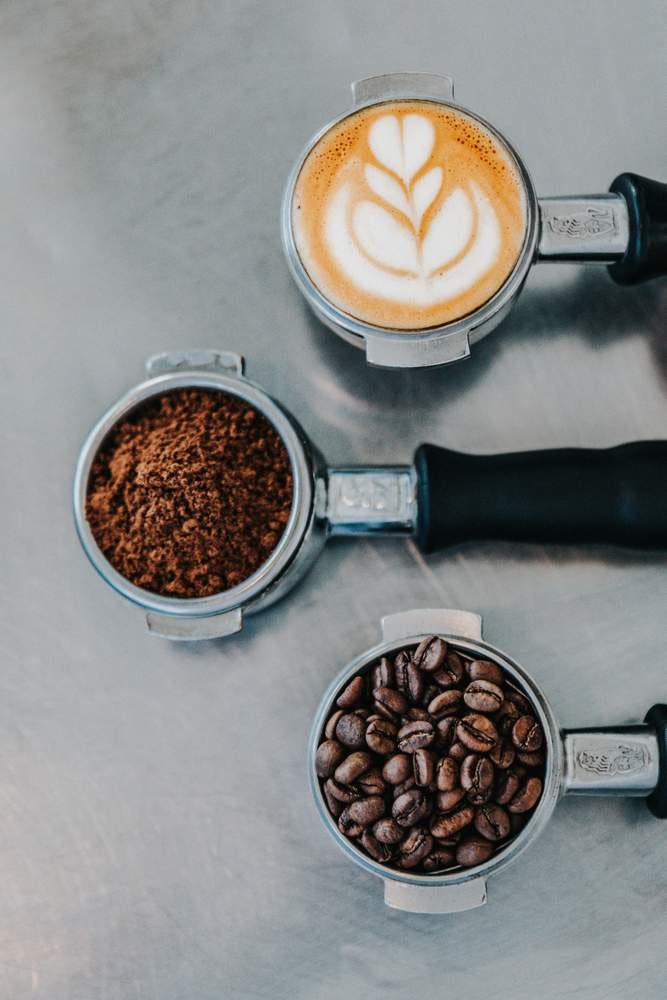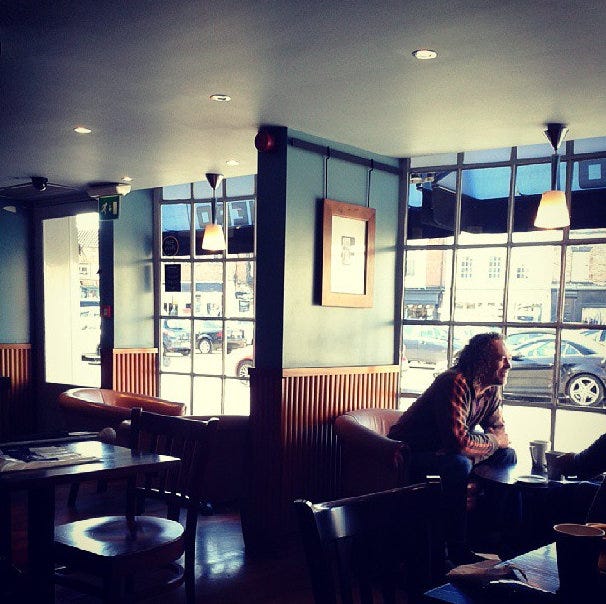How Can I Get My Memories Back?
A personal quest for the next season of Everything Is Amazing
About ten years ago, I became deeply interested in why modern coffee shops were such great places to sit and have interesting ideas.
Back then, I was recently back from a travel blogging conference in Rotterdam, where I’d given a talk on storytelling techniques. It had gone well - but the bit I’d hurriedly squeezed into the final five minutes of my talk really hadn’t. I’d been met with a sea of blank expressions, and one person said, “What - getting paid by your readers? That’ll never work.”
What I’d said in those five minutes was what I’d scribbled on a napkin in a local coffee shop the day before.
I’d recently been looking at how Charles Dickens first released The Pickwick Papers in 1836-37 - not as a book, but as a serialised pamphlet. As a trained journalist, Dickens started the project thinking it was going to be a single volume, for which he’d have to find an agent, etc. and blah blah as was usual for these things (and often still is). But what else was possible here?
Under his brave/reckless steerage, and with the help of a scrappy new publishing house keen to make a name for itself, he went full-on Netflix with it: a new segment of this story self-published to English readers every month. This would go on for nearly two years.
The result? Sales went nuts. And so did piracy! Bootlegs, poorly ripped-off characters, blatantly unofficial merchandising, the full works. But none of that mattered to Dickens, because of the incredible momentum his own approach generated.
The first instalment shifted a healthy 1,000 copies; the last sold about 40,000 (an astonishing number when you consider each was physically printed) - and since Dickens quickly saw the value of bundling the instalments into a single book at the end, he started his next series with that eventual book firmly in mind - while continuing to play on all the strengths of serialization that he'd discovered with the previous story. It was a career-building model.
I loved this so much. Not just because of the promise of this “new” way to write books, but also because it was directly serving and supported by readers. And outside of travel, I was seeing this everywhere - a big shift away from advertisers and corporate PR and top-down gatekeeping towards a more gloriously experimental indie mindset, a true “let’s change the rules” ethos, with one root running all the way back to Dickens.
This all came to me in a coffee shop, so I tacked it onto the end of my talk. I drew a diagram on a blackboard, I mumbled something about my beloved subscription to the comic 2000AD when I was a kid, I implored people to check out a relatively new startup called “Kickstarter” that was doing remarkable things for creators of all kinds - and I completely flubbed the delivery, because it was all off the top of my head. Total lead-balloon of a thing.
(I actually think I gibbered. If you’re giving a talk to people, never gibber. It’s the worst of looks.)
So then I went away discouraged, promptly forgot my own advice and went back to writing my blog.
Meanwhile, just a couple of weeks earlier, across the other side of the world, a tiny subscription-based membership platform for creators called “Patreon” had opened its doors for the first time, conceptually paving the way for Substack’s arrival four years later - and, well, here we are.
But - why a coffee shop? What is it about these places that break you out of your stuck thinking, triggering those unhinged flashes of insight that are probably rubbish but what if they weren’t??? - and letting your thoughts jostle around freely, bumping into all the cognitive furniture in your head until you find your thoughts in a very different state?
I wrote in my blog in 2014:
“[The ambient noise app] Coffitivity links to this research paper, which suggests that moderate ambient noise fosters creativity. Coffee-houses usually have a background noise level of around 70 decibels (dB). The paper’s authors found that a lower volume of noise helped with laser-focused concentration, but also helped strait-jacket the mind into a single way of thinking, one that blocked the abstract creation of new ideas from fragments of old ones.
This goes by the excitingly academic name of “processing disfluency”.
When your thoughts are “fluent,” they are bent solely on the task at hand (a path of least resistance for the mind) and they blot the rest of the world out – including everything else you’re thinking about. What background noise of the 70 dB variety seems to do is tug gently at your arm, like a small child trying to get your attention.
“Hey. Hey. Hey.”
It’s just enough of a distraction that it keeps you from sinking too far into what you’re doing, so you’re bouncing round near the surface of it, within grabbing-distance of other ideas in your head. And since your mind is jittery from all that caffeine and you’re presenting it with more of a challenge, your brain really wakes up . . . and starts to play “Hey, Does This Fit With That?”
I based this on what science writer Steven Johnson (now on Substack) was saying about how good ideas come together, as illustrated in this brilliant RSA Animate:
But there’s a critical assumption here: you’re showing up with the right number and the right quality of idea fragments. In today’s hyper-distracted world, that’s a big ask - because it requires recalling things.
My memory is mostly unreliable. I’m the kind of person who will be amazed when someone tells him what we had for lunch when we met last week. I never remember on what day each of the recycling bins are supposed to go out, I am truly awful at putting names to faces, and every time I’m enjoying my life (which is happening a lot these days, thanks to this newsletter) I worry that I won’t remember it later.
This is also a work problem for me. My job involves weaving rambling science-based stories out of the fragments of interesting ideas I’ve stumbled across and want to learn more about, and if I can’t capture those fragments in some way - ideally in my head - then my stories are going to be rubbish. Simple as that.
My ability to retain and recall things, aka. my “memory”, is increasingly precious to me. And until recently, I’ve never given it more than a moment’s thought. Isn’t it just, you know, there? I was born with it in the state it’s in right now, and I just have to work with what I’ve got?
It’s time to find out how wrong I am for assuming this.
In Season 6 of Everything is Amazing, running alongside the series on islands which I mentioned last time, I’m also running a series just for paid subscribers, on the power of applied memory.
I’ve briefly touched on this topic in this newsletter before, when I looked at Timur Gareyev, blindfolded multi-game chess Grandmaster extraordinaire:
How To Remember What Really Matters
Hello again! This is Everything Is Amazing, a newsletter about this, arranged like that. The great William Arthur Ward famously said, “The mediocre teacher tells, the good teacher explains” - and let me tell you, my friend, today’s installment is a real treat.
And taking a prompt from that piece, I’ll be looking at practical questions around the science of memory.
I want to find some ways to store things away in my brain in a form I’m much more confident of being able to retrieve later.
I want to know a few tricks for remembering what I want to remember, to curate my memories instead of taking enormous cognitive gulps of what’s around me at the time, like a photograph compared with a detailed sketch. (When I was an archaeologist, we learned to photograph and draw everything, because the latter is more of an argument about what you’re looking at, filtered through your interpretative skill.)
And of course, I want to find stuff that makes my inner child go WOW, all this new science is so cool. I’m tediously predictable like that. You know this, of course.
There are many much-smarter-than-me people to listen to on this topic. One is neuroscientist (and Professor of Experimental Brain Research at Trinity College Dublin)
, who writes on Substack at Brain Pizza and just recorded this overview of how memory works for Ireland’s RTÉ radio. There are books and science papers and scientists and professional rememberers galore to consult, it’s going to be great fun throwing myself into all of it, and I’ll be taking lots of notes (mainly because my memory is so rubbish).I’ll be passing along to all paid subscribers absolutely everything I learn as I learn it, in the hope it’s useful to you too.
Tonight, the week-long discount for all paid subscriptions to Everything Is Amazing will be running out.
Beginning next week, I’ll be on a six-week break. During that time, paid subscribers will get new pieces (some of which will pave the way for the next season’s deep dive into memory), I’ll be starting doing those “curiosity calls” that I mentioned here - and I’ll also be working on the relaunch of my non-fiction storytelling course, which about 50 of you went through last year in its earlier, non-updated form. It’s definitely time to get that out the door.
So if you want to be part of this whole project with a recurring discount, now’s the time to act:
But for now, thanks so much for reading and your support and kind words on this crazy journey so far. I’m grateful, I’m exhausted, and I’m off for a truly legendary nap.
See you soon.
- M
Images: Nathan Dumlao; Mike Sowden.





Fantabulous, Mike! I'm very excited for this and also still think your "seasons" model for your newsletter was a brilliant innovation I wish I'd thought of.
At a conference I was just at, I talked for a while with an editor at an academic press, and we talked about how publishing a book online might benefit an eventual final whole printed book. It was good for me because I could clarify my thinking around what I'm doing and why, but also get some of her thoughts about the risks that publishers see, which is essentially that people who've already read something online won't pay for the whole book later. Which, considering the success of Leslie Jamison's first essay collection among others, is belied by what actually happens.
Not that people need to get publishers on board with this, it's just something I'm personally interested in seeing because I miss having an editor and don't know anything about design or marketing, etc., and am curious to see if publishers--at least smaller, indie, or academic ones--can start envisioning the book ecosystem differently. I said to this editor, and we both laughingly agreed, that it feels like a lot of things are in constant "beta" right now.
Anywho. Please do a post on how PTSD and complex PTSD (as described in a lot of places but most vividly in Stephanie Foo's recent book "What My Bones Know") and other kinds of trauma lead to memory problems. And traumatic brain injuries. As interested as I am in how memory works, I also have a keen interest in the many invisible ways it can be damaged.
Have a fantastic break!
Looking forward to parallel memory season as well as islands. Just finished putting up a rough draft of a novella, scene by scene on my substack over 4 months. I will then publish final version as ebook in about a month. This is definitely an experiment, so looking forward to polling my readers on who read as the scenes came out, who waited until all done, or those who waited to buy finished version. And as this and most of my work is set in 19th century I was well aware of serialization in magazines as common way books first appeared, so I was curious to see how this worked in 21st century. But as for memory issues, at the age of 73, with a father who started showing symptoms of his Alzheimer's by late 70s, I find myself paying more and more attention to when my memory works well, when it doesn't, so I will be very interested in what you discover. Also particularly fascinated by the Steve Johnson video. Since health issues keep me isolated in terms of face to face interactions, but daily phone calls and my growing interaction in the substack environment has made me, if anything, more interconnected than I have ever been before, I was pleased with his conclusion about not needed the coffee shop to come up with creative ideas! In short, really looking forward to this coming season.